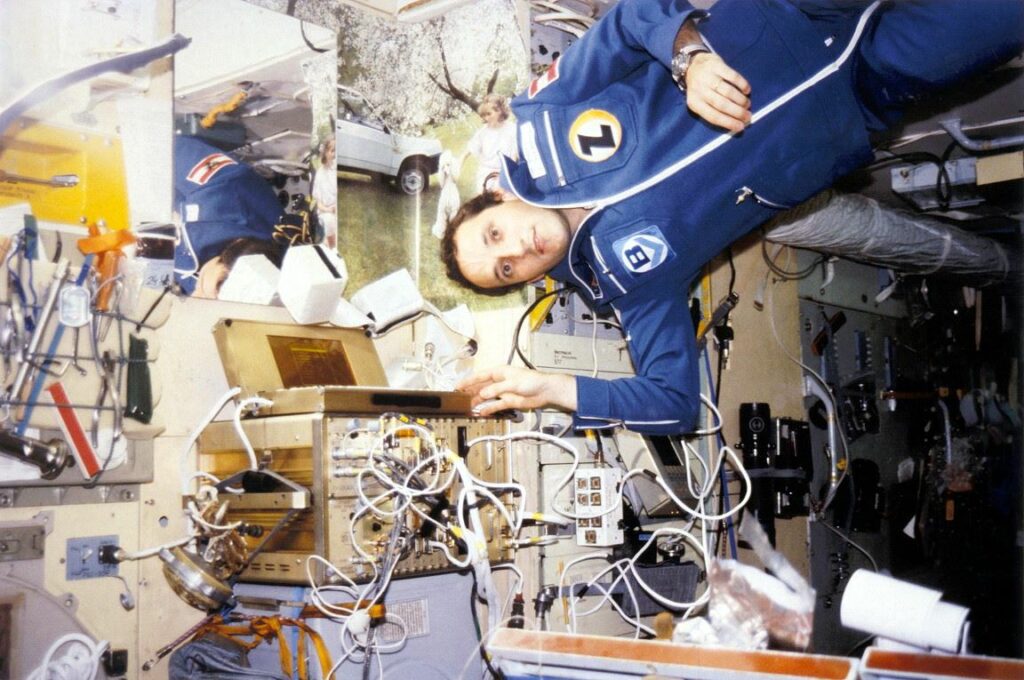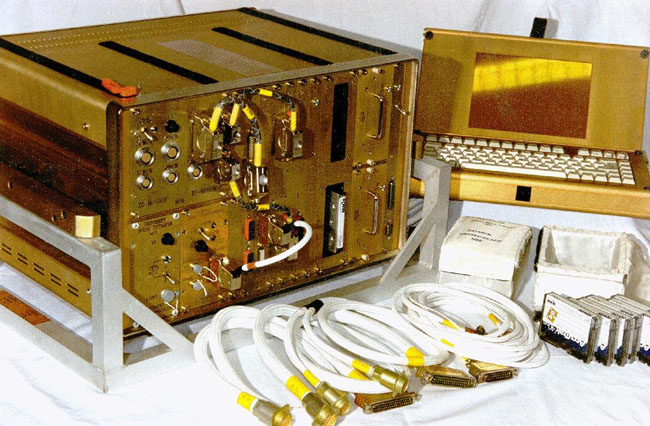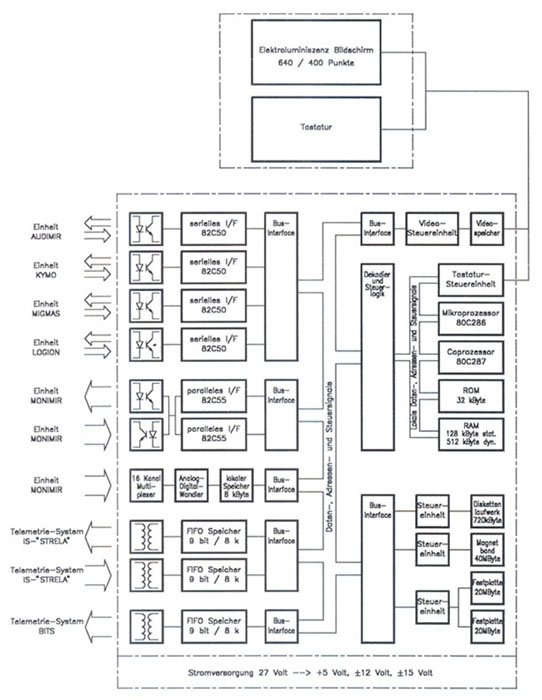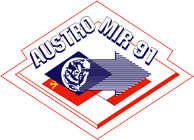DATAMIR is a computer system for the acquisition and recording of the medical und physical experiment`s data during the project AUSTROMIR 91. When the space station orbits the earth ones in about 90 minutes, there is between this and the flight routing center (ZUP) in Moscow only a ten to fifteen minutes telemetry contact time. Because of that only ten to fifteen percent of the whole data could be transmitted to earth quasi on-line; enough to allow the experimenters a kind of accompanying check of the experiments. The experimenters data were saved on board and twice per day saved on magnetic tapes. The magnetic tapes were brought back to earth with the cosmonauts.
The industry unit of the typ IBM/AT had to be adapted into a board computer for the space station MIR, to affect the bulk of the AUSTROMIR-experiments, to record all experiment data, and supply the cosmonauts with the necessary briefings, outlines and checklists for the preparation of the experiments. The board computer already transferred experiment data during the mission over two available telemetry systems from the space station to the earth station.
Requirements
The mechanical loads at a rocket launch are very high, so that a normal computer would be destroyed through it. The development team had so not only to write the complete software, but also to adapt the hardware for space conditions. The computer case in which the system DATAMIR as well as the special experiment modules were placed, were suspended with vibration absorbers in a special transport frame. The hard disks were transported seperate from the central unit in a special case.
Safety and reliability had the highest priority at the development, because the successful realization of the most experiments depended from the functioning of the on-board computer. For almost every elemt spare part were available on board of the space station.
DATAMIR was a very special challenge. The development order had been refused from some industrial firms with the reason, that such a complex project would take five years and would cost not less than 50 million Schilling. The Research Association Joanneum Ges.m.b.H got after the request of the Federal Ministry of science the contract and in only two years DATAMIR as experimental unit was developed for 13 millionen Schilling. For the involved scientists and technicians it was a “tour de force”. It was the final element in the chain and every delay in the preparatory works for the DATAMIR controlled experiments caused an enourmous time pressure. So the definitive ultimate version of the software was brought to the space station with Franz Viehboeck.
Application for controling and data recording at the realization of the Austrian experiments:
AUDIMIR, MONIMIR, OPTOVERT, MIKROVIB, PULSTRANS, MOTOMIR, COGIMIR, LOGION, MIGMAS-A
Results
All DATAMIR supported experiments could be accomplished as planned. The data, nearly 72 million bytes, were brought to earth saved on eight streamer cassettes.

Several bugs that arised during the flight could have been removed during the mission. Greater incidents came up at the decoding of the telemetry datas as a result of troubles in the transmission system. The modifications at the software could compensate the malfunctions completly. In face of this unpredictable problems all experimenters got sufficient information, that they could evaluate the quality of the realization of the experiments even during the flight.
For the use of DATAMIR the expenditure of time for the realization of the experiments was minimized and a multiplicity of scientific tests were accomplished in a very short time. Related to previous missions on the MIR kept the record in the relation between the layed out time and the performed work.
Practical application
Application ranges
- Experimental and clinical medicine
- Industry and space technology
Application target
- Automation of clinical-physiological tests and industrial processes
Direct interested institutions on the utilization of the experiment results
- Institute for Applied System Technology, Research Association Joanneum Ges.m.b.H, Graz
- Institute for Biomedical Problems, Moscow
- “J.A. Gagarin” – Cosmonauts training center in Svjosdnyj Gorodok near Moscow
Technical characteristics
The system consisted of the following units
Central unit
The central unit based on an industrial computer of the typ IBM/AT and had the following technical main characteristics:
- Microprocessor:80C286
- Clock frequency: 10 MHz
- RAM: 640 kByte
- ROM: 32 kByte
- Floppy-disk: 720 kByte
- Streamer: 40 MByte
- Digital interfaces:
serial 4 channels
parallel 1 x 16 Bit
Interface to the board telemetry system BITS
Interface to the board telemetry system STRELA - Analog inputs: 16 channels, +10 V
- Overload protection: fuse 6.3 A
- Controls:
Power switch
Dispatcher for the hard-disks - Indicators:
Power control display
Operation display for the Floppy-disk
Operation display for the hard-disk (2 pieces)
Operation display for the streamer
Check display for the processor supply (+ 5 V)
For the transport to the space station MIR the central unit was provided with a vibration depressant transport frame. In the central unit DATAMIR the electronic box MONIMIR, the electronic box AUDIMIR and the supply block OPTOVERT were built in.
| Mass: | (Transport configuration) (Operation configuration) |
max. 24.0 kg max. 22.0 kg |
| Dimensions: | (Transport configuration) (Operation configuration) |
552 mm x 320 mm x 432 mm 470 mm x 280 mm x 362 mm |


Aluminium container with following system components:
- Operating unit consisting of a monitor (monochrome, 640 x 350 pixel) and a keyboard (German – Russian)
- Cable loom (4 cables)
- Disk set in a cloth bag (6 disks)
- Streamer cassette sets in a cloth bag (2 sets with ever 6 cassettes)
- Reserve fuses
| Mass: | max. 10.0 kg |
| Dimensions: | 470 mm x 120 mm x 350 mm |
Hard-disk modules
Two hard-disk modules (each 20 MByte) were transported to the MIR packed in depressant foam plastic packages with cloth bags and first there built into the central unit.
| Mass: | max. 1.5 kg |
| Dimensions: | 140 mm x 200 mm x 330 mm |
The total power use of DATAMIR amounted max. 80W.
To increment the redundancy a set DATAMIR – spare parts consisting of the following components was accommodated into the scope of delivery:
- Video card
- Analog / digital transformer card
- Serial interface card
- Parallel interface card
- Main board
- Streamer / floppy-disk – unit
- Fuses 6.3 A (10 pieces)
These backup plates were individually packed into antistatic foil bags and into a cloth bag.
| Mass: | max. 4.9 kg |
| Dimensions: | 320 mm x 320 mm x 200 mm |
To the spare part set an aditional hard-disk module with transport packaging was added.
| Mass: | max. 1.5 kg |
| Dimensions: | 140 mm x 200 mm x 330 mm |
The transport of the spare parts to the MIR occured simultaneous with the equipment DATAMIR in the cargo transporter Progress M-9.
Back load
- Two streamer cassette sets in foam plastic depressant cloth bags each with six cassettes
| Mass: | max. 750 g |
| Dimensions: | 117 mm x 107 mm x 87 mm |
Experimenters
o.Univ.-Prof. Dipl.-Ing. DDr. Willibald Riedler (institute manager)
Dipl.-Ing. Manfred Steller (project manager)
Dipl.-Ing. Thomas Stockhammer
Dipl.-Ing. Paul Willière
Dipl.-Ing. Christian Wagner
Anton Wenzel
all: Institute for Applied System Technology, Research Association Joanneum Ges.m.b.H, Graz
